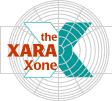
 |
|||||||
Xara X. Chapter 15 — Bitmaps |
|||||||
|
|
|||||||||||||||||||||||||||
|
The circle on the left is non-anti-aliased, that is a long way of saying, it has not been softened. The circle on the right has been Anti-aliased using intermediate shades of gray to soften the hard black outline against the white background. When we reduce the size of the two bitmap circles as shown to the top left of each circle, we can see the smoothing effect. The Anti-aliased circle actually looks sharper than the circle on the left. Anti-aliasing not only smoothes the outline of the shape, it also makes the edges appear sharper. |
|
The duck was scanned from a black and white image. With just black and white, the image is ragged. If we increase the number of colors to 16, the image appears smoother. Increasing the number of colors to 256 makes only a very subtle difference. |
|
Dithering is a process of making tiny patterns using a small number of colors to give the impression of more colors. The top, left circle was exported to bitmap using only 16 colors. (It is the same circle shown in the lower right corner). Because of the limited number of colors, the circle solid shows bands of colors. The top right circle was exported to bitmap with the same 16 colors, but this time dithering has been applied making the banding less obvious. At 256 colors, there is not as much need for dithering.
Adding more colors, as seen on the two circles shown below, eliminates the need for dithering. The more colors we have to work with, the smoother the results. The bottom right image is also called True Color and utilizes a palette of 16.7 million colors. |
|
Notice the highlight area on the GIF image is showing some banding while the highlight on the JPEG sphere is smooth. Even though the JPEG uses more colors, the JPEG file is 7K vs. 9K for the GIF. And the JPEG looks better too. So the next logical question is when should you save a file as a GIF and when should you save a file as a JPEG? The general rule of thumb is images that contain mostly solid areas of color, or images that contain a lot of text, should be saved as GIF files. Also, Web images that require transparent backgrounds, should be saved as GIFs because at the current time, JPEG images do not support transparent colors. PNG (pronounced ping) files can have transparent backgrounds, but are not supported by older browsers. Images that are photographs, or that contain subtle gradations of color, such as the sphere, look better, and produce smaller file sizes, when saved as JPEGs. |
|